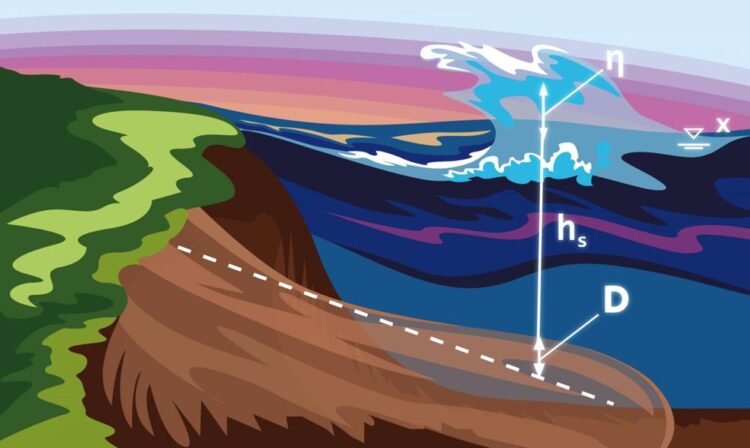Scientists improve model of landslide-induced tsunami

Tsunami induced by a landslide.
Credit: Daria Sokol/MIPT Press
Office
MIPT researchers Leopold Lobkovsky and Raissa Mazova, and their young colleagues from Nizhny Novgorod State Technical University have created a model of landslide-induced tsunamis that accounts for the initial location of the landslide body. Reported in Landslides, the model reveals that tsunami height is affected by the coastal slope and the position of the land mass before slipping. The highest and most devastating waves result from onshore landslide masses. This realization will make future predictions of tsunamis more accurate, as well as providing deeper insights into past events.
The recent decades have seen unusually large tsunamis that had on-shelf sources and were not always accompanied by seismic events. Instead, the underlying cause may be a fully or partially underwater landslide.
Researchers come up with models to predict wave runup onto the shore following a landslide on an underwater slope. The challenging part is to account for the nonlinear nature of wave runup and rundown, as well as the complex shelf zone geometry. Another important factor at the heart of the models is the technique used to compute landslide mass movement.
A number of landslide-induced tsunami models have been developed, with two of them used the most. The so-called rigid-block models assume a solid state perspective on the motion of the landslide, with shallow-water equations governing the generation of surface water waves. Models of the other type — referred to as viscoplastic — rely on shallow-water equations to describe both surface wave generation and landslide movement.
Despite a number of refinements accounting for some features of landslide mass movement, the models have so far remained hydrodynamic in their nature. This means they are not helpful for analyzing the detailed structure of the landslide body or the characteristics of its constituents during the slip. But unless the actual physical properties of the landslide mass are considered, modeling its movement is problematic.
The study reported in this story employs an elastoplastic model presented in 2000 by Igor Garagash and Leopold Lobkovsky. It accounts for the detailed structure of the landslide body and the mechanical characteristics of the land mass constituents during the slip, as well as incorporating the processes occurring in the landslide body. The model implementation in the study relied on the programming code called FLAC 3D, which enables calculations under an explicit finite-difference scheme for solving three-dimensional problems of continuum mechanics.
The researchers found that wave runup onto the shore varied considerably depending on the initial position of the landslide body on the shelf slope, even when the other parameters were fixed.
“In contrast to other models, where the tsunami wave climbs the original coastal slope, here the slope surface is continuously transformed during the landslide motion,” study co-author Raissa Mazova from MIPT explained. “In other words, at each moment of time, the tsunami runup occurs onto a new surface of the coastal slope, which leads to a complex displacement of the shoreline. Such an effect has not been obtained before, and it is impossible to obtain within the framework of the movement of a landslide as a solid body or within the framework of a viscous model.”
The role of the sediment layer on the slope also proved substantial. The numerical simulation predicts maximum runup on the slope for tsunamis induced by landslide masses initially located on a dry shore.
“Rather than attempting to implement a novel methodology for calculating a landslide model, we used a familiar model, introducing additional boundary conditions,” commented Leopold Lobkovsky, a member of the Russian Academy of Sciences and the head of the MIPT Laboratory of Geophysical Research of the Arctic and Continental Margins of the World Ocean. “Our findings demonstrate that shoreline dynamics significantly depend on the initial location of the landslide body, with the shoreline point potentially shifting. This feature may enable us to infer some information about the location of the submarine landslide by solving the inverse problem after a tsunami has taken place.”
“However, the inverse problem is fairly difficult to solve, even when determining the location of the seismic source of a tsunami, and it is not always possible to achieve adequate results. That said, we have already begun a study to that end, and hope to estimate the locations of the landslides and gain insights into their nature,” the researcher added.
All latest news from the category: Earth Sciences
Earth Sciences (also referred to as Geosciences), which deals with basic issues surrounding our planet, plays a vital role in the area of energy and raw materials supply.
Earth Sciences comprises subjects such as geology, geography, geological informatics, paleontology, mineralogy, petrography, crystallography, geophysics, geodesy, glaciology, cartography, photogrammetry, meteorology and seismology, early-warning systems, earthquake research and polar research.
Newest articles

Parallel Paths: Understanding Malaria Resistance in Chimpanzees and Humans
The closest relatives of humans adapt genetically to habitats and infections Survival of the Fittest: Genetic Adaptations Uncovered in Chimpanzees Görlitz, 10.01.2025. Chimpanzees have genetic adaptations that help them survive…

You are What You Eat—Stanford Study Links Fiber to Anti-Cancer Gene Modulation
The Fiber Gap: A Growing Concern in American Diets Fiber is well known to be an important part of a healthy diet, yet less than 10% of Americans eat the minimum recommended…

Trust Your Gut—RNA-Protein Discovery for Better Immunity
HIRI researchers uncover control mechanisms of polysaccharide utilization in Bacteroides thetaiotaomicron. Researchers at the Helmholtz Institute for RNA-based Infection Research (HIRI) and the Julius-Maximilians-Universität (JMU) in Würzburg have identified a…



